Fancy Children’s Parks Tailored for Citizen Customers
Background
Children’s Parks in Narrow Areas & Sluggish Remodeling Projects
There are 2,119 city parks in Seoul, of which 1,297 are children’s parks for children aged 2 to 12, with disposition distance of less than 250m. While the total area of city parks is 115.94km², the area of children’s parks is 2.22km², comprising only 1.91% of the entire park area. The size of children’s parks in Seoul varies, from a minimum of 11m² to 20,820m². Small parks for children (less than 1,500m²) make up the majority of children’s parks (around 57%).
<Table > Status of Parks in Seoul
| Type of Park | Total | City Park | Natural Park | Other Park | ||||||||||
| Sum | Urban Natural Park | Living Area Park |
Theme Park |
|||||||||||
| Neighborhood Park | Children’s Park | Small Park | Sports Park | Cemetery Park | Culture Park | History Park | History Park | History Park | ||||||
| No. of Parks (Places) | 2,714 | 2,119 | 20 | 392 | 1297 | 346 | 4 | 4 | 39 | 11 | 5 | 1 | 1 | 594 |
| Area (㎢) | 169.12 | 115.94 | 65.56 | 44.06 | 2.22 | 0.46 | 0.13 | 2.42 | 0.59 | 0.44 | 0.04 | 0.05 | 39.35 | 15.84 |
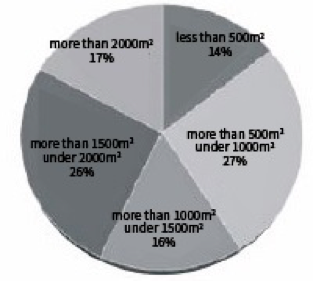
Many of the children’s parks were unable to attract children because they were extremely run down and boring. In addition, a significant portion of children’s parks were converted to senior citizens’ community centers, daycare centers, physical training facilities, etc., making it difficult for the parks to fulfill their original purpose for children.
In order to improve the situation of children’s parks, Seoul has since 1994 facilitated children’s park renewal projects including ‘Creation of Resident Participation Children’s Parks,’ ‘Children’s Park Improvement Tailored to the Living Area,’ etc., based on its ‘Modernizing Plan for Children’s Parks’. In the beginning stages the park remodeling projects had focused on the appearance of facilities, with projects such as replacement of existing facilities with modern ones and introduction of unusual shapes to playing facilities. As a result, the usage rate of children’s parks remained low because substantial improvements had not been made and the management was inadequate.
<Table 1 > Timeline of the Children’s Park Remodeling Project of Seoul
| Period | Description |
| Before 1994 | • Redevelopment of 22 parks using examples based on the ‘Modernizing Plan for Children’s Parks’ → Currently implemented by the autonomous gu-district. |
| 1995~2005 | • Change of project names to “Children’s Parks Filled with Green,” “Reorganization of Resident Participation Children’s Parks”, etc. • Facility upgrades for around 520 parks was planned, but not implemented. |
| After 2005 | • Remodeling projects are in the process of implementation, with changes in the project names to “Creation of Children’s Parks Tailored to the Living Area,” “Creation of Fancy Children’s Parks,” etc. |
Main Age Groups & Use of Children’s Parks
Low Satisfaction with & Safety at Children’s Parks
The number of child safety accidents increased from 146 in 2004 to 307 in 2006 (Korea Consumer Agency, 2008). The main causes were broken pieces of timber or rust on the playing facilities. This implied that there were problems regarding facility safety. Users were more exposed to incidents because guidance facilities necessary for safety management were not installed in the parks, or the regulations for safety prevention were not adequate. In addition, fewer than half of the parks (49.6%) had signs or posts containing information about the managing entities and only 24% of such notices had contact information. This led to less safety in the parks.
According to the surveys, not only safety, but also user satisfaction of the children’s parks was low. The main causes of low user satisfaction were the boring playing facilities and insufficient subsidiary facilities. The users wanted subsidiary facilities such as toilets (which showed the lowest satisfaction rate), drinking fountains and trash cans to be improved, as well as facilities for the disabled, the elderly, the infirm and children. Children wanted sufficient playing facilities and floor pavement for safety. In addition to improving the facilities, users wanted prevention of noise in the parks, no admittance of drunken people, and pet management, to ensure the safety of the parks at night.

Progress
Expansion of the Concept of Fancy Children’s Parks
In order to enable children to conveniently use the playing facilities in safety, and to establish an effective safety management system based on the Act on Safety Management of Playing Facilities, Seoul integrated the previously-separated management of children’s parks and children’s playgrounds. Seoul planned to redevelop the existing children’s parks, but expanded the concept of ‘fancy children’s park’ to include children’s playgrounds, considering that 56% of Seoul’s population lived in apartments and used playgrounds in their own apartment complexes.
Selection of Project Places for Fancy Children’s Parks
The project to create fancy children’s parks in 304 children’s parks in 25 autonomous gu-districts has been commenced. Based on the project plans, Seoul began to develop the existing simple and older children’s parks into “Theme Playing Parks” and “Regional Community Spaces” better able to foster children’s dreams, creativity, and imagination. In the process of park development, children and residents directly participated in the projects.
Development Strategy
Seoul established the following development strategy for the creation of fancy children’s parks:As a part of this strategy, Seoul plans to have discussions with children through special programs in the schools and to invite parents, to collect their opinions. For design, Seoul holds design workshops and expands the possibilities for civil participation via the introduction of a citizen and consumer supervising system. With an aim of creating pleasant and safe parks, Seoul must use eco-friendly materials. When installing sand playgrounds, safety from dog ascaris (roundworms) and heavy metal pollution will be considered. Themes shall be assigned to the park designs and the park designs shall be made in accordance with these themes.
Budget for the Fancy Children’s Park Project
Implementation of Fancy Children’s Park Project
| Idea contests for citizens, consumers, and college students | è | Design Contest for the pilot models | è | Selection of best designs (design companies) | è |
| Basic plans (drafts) | è | First presentation to residents | è | Adjustment of plans (drafts) after the first presentation to residents | è |
| Second design workshop | è | Plans (drafts) made via the resident participation design process | è | Review and deliberation with the autonomous gu-districts | è |
| Reflection of deliberation results to the plans (drafts) | è | Order | è | Implementation of construction |
Establishment of Plan for Children’s Park Improvement Project
On September 12th, 2007, in order to address users’ increasing complaints about children’s parks, low usage rates by children and above all, the necessity to improve the safety of the old playing facilities which did not meet safety management standards, Seoul announced by the Mayor’s Instruction No. 179 the children’s park project plan, which had been facilitated to review the integrated methods to improve children’s parks and to implement the remodeling of entire playgrounds in all autonomous gu-districts.
Project Name and Status Investigation of the Target Locations
In October 2007, Seoul held an investment assessment for the fancy children’s park project, established the general improvement plan for the children’s parks and decided the project name would be “Fancy Children’s Parks Tailored for the Public”. It also investigated the target locations for the project in the 25 autonomous gu-districts.
Formation of Advisory Committee
In February 2008, Seoul formed an advisory committee for the implementation of the fancy children’s park project and investigated if the project was contradictory to the urban development project, in order to select target locations.
Idea Contest for College Students & the General Public
On March 5th, 2008, Seoul held an idea contest for the general public and college students, based on the basic concepts of the “Development Plan of the Fancy Children’s Park Tailored for the Public”. Its purpose was to collect citizens’ ideas and opinions on the concerns they had while using the children’s parks, and on the facilities that citizens wanted to introduce. The ideas of college students regarding space organization, design and playing facilities, park character, etc. were used in planning and producing guides for the pilot model contest.
Prize Contest for the Pilot Model
Seoul selected 10 representative locations for the contest through advisory committee meetings for site selection.
Selection of Excellent Designs (Design Companies)
The best designs for the 10 pilot model locations were selected. The prize winner for each pilot model location was to be granted the opportunity to design 9 more locations, so that a prize winner for a location would take responsibility for planning and designing 10 locations in total. Five design companies were awarded the best of the pilot models for 2 locations each, so each company was responsible for planning and designing 20 places.
Basic Plan (Draft)
Based on the pilot models, the design companies established their basic plans for 20 locations.
First Presentation to Residents
Seoul held presentation sessions for local residents. Events were held in primary schools for children in grades 4 to 6 as part of inquiry instructions in social studies. The children presented their opinions in the form of pictures and texts using the titles “The playground that I want to make” and “Please make our parks like this”. The experts announced the basic plans (drafts) to children and residents to determine their responses and opinions.
<Figure 4> First Presentation for Residents and Children’s Opinions

Second Design Workshop
The adjusted plans (drafts), based on the opinions raised in the presentation sessions were explained during design workshops held in the children’s parks.
<Figure 5> Second Design Workshop

Plans (Drafts) Made via the Resident Participation Design Process
Review & Deliberation with the Autonomous Gu-Districts
Results
Orders & Implementation of Construction
Effects
Results of the Fancy Children’s Park Project
The total area of the redeveloped 304 locations was 425,436㎡, which is almost twice the area of Yeouido Park (229,539㎡). Because preferential selection was applied in regions with poor living environments, the fancy children’s park project was able to contribute to the improvement of regional green spaces, playgrounds, rest areas, supply of community spaces, etc.
<Table 3> Redevelopment Status of Fancy Children’s Parks
| Name of Autonomous Gu-District | No. of Children’s Parks | Fancy Children’s Parks | Name of Autonomous Gu-District | No. of Children’s Parks | Fancy Children’s Parks |
| Jongno | 24 | 3 | Mapo | 55 | 13 |
| Jung | 22 | 1 | Yangcheon | 71 | 12 |
| Yongsan | 32 | 3 | Gangseo | 125 | 20 |
| Seongdong | 33 | 8 | Guro | 25 | 11 |
| Gwangjin | 35 | 15 | Geumcheon | 41 | 13 |
| Dongdaemun | 52 | 4 | Yeongdeungpo | 32 | 4 |
| Jungnang | 44 | 21 | Dongjak | 34 | 8 |
| Seongbuk | 36 | 6 | Gwanak | 70 | 25 |
| Gangbuk | 40 | 9 | Seocho | 84 | 4 |
| Dobong | 39 | 24 | Gangnam | 61 | 6 |
| Nowon | 92 | 36 | Songpa | 82 | 13 |
| Eunpyeong | 47 | 16 | Gangdong | 64 | 19 |
| Seodaemun | 44 | 10 | Total | 1,284 | 304 |
The fancy children’s parks, created with various new-concept themes, were favorably received because the features of the parks were expected to increase children’s interest and develop creativity and imagination. In the case of Wau Fancy Children’s Park, the pictures painted by the children from Hongik Elementary School’s fifth grade were made into tiles and installed in the park, which provided much pride and affection for the children themselves. The children’s works from Seogang Elementary School were also installed in the Changjeon Fancy Children’s Park.
<Figure 6> Kkachi Fancy Children’s Park -Exciting Space Travel |
<Figure 7> Seockchon Fancy Children’s Park – Adventures of Robinson Crusoe |
<Figure 8> Boram Fancy Children’s Park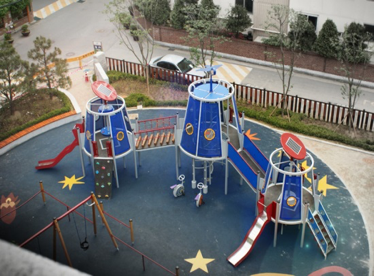 |
<Figure 9> Hagye Fancy Children’s Park – Playground of Fairy in the Forest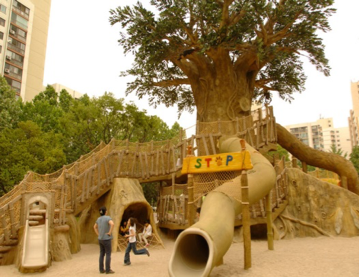 |
<Figure 10> Siny Fancy Children’s Park – Smurf Village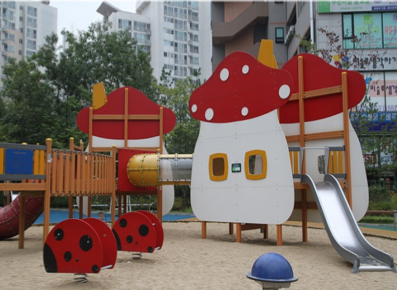 |
<Figure 11> Hodori Fancy Children’s Park – Concentric Circles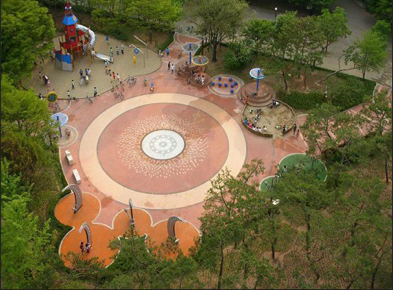 |
Evaluation
References
- Mi-suk Shin, 2010, “A Study on the Assessment Made after the Fancy Children’s Park Project”, University of Seoul
- Won-ju Kim, 2009, “Children’s Park Improvement Strategy to Induce Imagination and Creativity”, Seoul Development Institute
- Won-ju Kim, 2008, “A Study on How to Improve the Children’s Park through the Users’ Evaluation”, the Seoul Institute